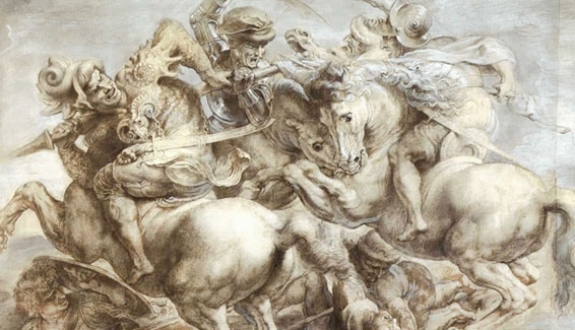Stupendously gifted, internationally famous and living to the age of 67, Leonardo da Vinci did not lack the opportunity to complete great and lasting works. His patrons were the most powerful men of the era – the Medici, the Borgias, the Duke of Milan, the Pope, the king of France – and he was in continual demand for altarpieces, portraits, murals and monuments. At the same time his brain (famously, even then) teemed with extramural ideas in anatomy, mathematics, engineering, architecture, natural history, optics, cosmology, stage design, powered flight, weaponry, games, stories, jokes and toys, all of which he detailed in thousands of notebook pages.
Yet today he is most famous for the “Mona Lisa”, a work to which he returned intermittently for 16 years and still considered unfinished, for the great “Cartoon” in London’s National Gallery, supposedly a preparatory work for a mighty picture that never materialised, and for the “Last Supper”, whose technical problems threaten its very survival. In all he brought fewer than a dozen works of art to completion and, of his other schemes, only a handful got beyond the drawing board. Of his architecture, only a few plans and sketches survive.
To measure this record against his reputation as the “universal man” is to confront the Leonardean enigma. Despairing of a solution to the puzzle, the art historian Kenneth Clark wrote haplessly that “Leonardo was the Hamlet of art history, whom each of us must recreate for himself”. The National Gallery’s new exhibition Leonardo: A Painter at the Court of Milan, opening on November 9, will allow everyone to have a tilt at decoding and recreating Leonardo, by returning to his self-definition. He did not, it argues, primarily see himself as scientist, engineer, aeronaut or any of the other labels implicit in London’s last big Leonardo show, Martin Kemp’s Experience, Experiment and Design at the Victoria and Albert Museum five years ago. Rather, he was first and last a picture-maker, and the show seeks to celebrate his achievements in paint, under his most significant patrons the Sforza of Milan.
There is no question about Leonardo’s brilliant conceptual skills or his supreme draughtsmanship. One puzzle is actually more prosaic: how could so intelligent and superbly trained an artist make such catastrophic technical mistakes?
Take his lost painting, “The Battle of Anghiari”. Leonardo was commissioned in 1503 to cover a wall of Florence’s council chamber with a mural depicting Florence’s victory over Milan six decades earlier. This battle may in reality have been a disappointingly bloodless affair with, according to one source, just a single fatality when a soldier fell off his horse. No matter. A few years earlier Leonardo had written himself a brief for painting a no-holds-barred cavalry clash of unparalleled ferocity, stressing that all the tangled violence and agony of mass slaughter must be evoked, with no part of the ground unslaked with gore. The known preliminary sketches for “The Battle of Anghiari” suggest that it would have been one of the world’s most marvellous paintings.



